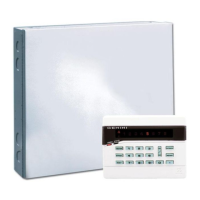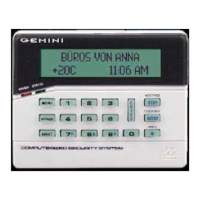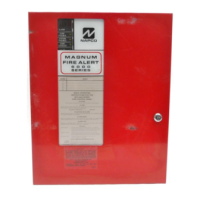Do you have a question about the NAPCO x255 and is the answer not in the manual?
Initial setup for Classic GEM-RP1CAe2 keypad.
Initial setup for K-Series GEM-K1CA keypad.
Details on button mapping between Classic and K-Series keypads.
Procedures for programming via PC connection, local or remote.
Keypad-based programming using guided menus.
Keypad-based programming using direct address entry.
Keypad-based programming for authorized users.
Information before entering Dealer Program Mode and steps to access it.
Creating a custom default system configuration.
Setting total zones, fire, exit/entry, interior, 24-hour, chime zones.
Configuring chime 2, exit/entry2, loop response, sensor watch, bypass.
Configuring telco fault test, keyfob chirp, and other zone features.
Configuring SIA CP-01 features and number of keypads per area.
Setting the central station telephone number.
Configuring auto download ID and callback numbers.
Entering the central station account number.
Selecting the central station receiver format.
Defining user permissions and access levels.
Assigning access control permissions to specific keypads.
Descriptions of various user options and their functions.
Defining user options specific to ACM access control.
Assigning ACM area access to users.
Mapping transmitters to zones and entering RF ID.
Assigning keyfobs as arm/disarm devices or zone inputs.
Configuring keyfobs as panic devices.
Entering custom descriptions for each zone.
Setting the system date and time.
Entering the dealer code for system access.
Procedures for resetting or clearing dealer and entire programs.
Understanding the mode and address display formats.
Example of programming using binary format for zone features.
Example of programming using decimal format for delays.
Example of programming using hexadecimal format for reporting codes.
Guidelines for using worksheets and programming steps.
Configuring exit/entry delays, abort delay, etc.
Configuring chime time, AC fail delay, sensor watch delay.
Setting output timeouts and report delays.
Setting panel access, ambush, and dealer security codes.
Choosing from available receiver format types.
Configuring digits for pager reporting format.
Setting specific options for CS receivers.
Setting ring count for automatic download pickup.
Entering numbers for callback during downloads.
Setting security code and selecting callback number.
Configuring opening/closing and event IDs for Telco 1.
Configuring opening/closing and event IDs for Telco 2.
Defining codes for alarm and trouble events.
Defining codes for system openings and closings.
Defining system-wide reporting codes.
Setting codes for system events and keypad actions.
Defining system-wide reporting code values.
Setting area-specific reporting behavior.
Setting system-wide report options.
Configuring codes for control panel and grouped zones.
Selecting modem codes for zone reporting formats.
Assigning reporting codes for users 1-96 across Telco 1 and 3.
Setting reporting for various system events like burglary, AC fail, EZM tamper.
Setting reporting for events and troubles in Area 1.
Setting reporting for events and troubles in Area 2.
Setting reporting for events and troubles in Area 3.
Setting reporting for events and troubles in Area 4.
Setting reporting for events and troubles in Area 5.
Setting reporting for events and troubles in Area 6.
Setting reporting for events and troubles in Area 7.
Setting reporting for events and troubles in Area 8.
Group zone options like loop response, entry/exit, reporting, and area assignments.
Group zone options like loop response, entry/exit, reporting, and area assignments.
Group zone options like loop response, entry/exit, reporting, and area assignments.
Group zone options like loop response, entry/exit, reporting, and area assignments.
Group zone options like loop response, entry/exit, reporting, and area assignments.
Group zone options like loop response, entry/exit, reporting, and area assignments.
Guidance on selecting options and understanding notes.
Settings for disabling fire reset and enabling day zone watch.
Setting options for reporting, bypass, access control, and alarms.
Settings for trouble audibility, bypass, output control, and reporting.
Configuring phone dialing prefixes and pager recall/format settings.
Assigning types and areas to up to 15 keypads.
Enabling features like fire, panic, auxiliary, ambush, and access control for keypads.
Defining zone numbers for door contacts, forced entry, and door ajar.
Configuring global flags and access control timeouts.
Assigning arm/disarm, stealth, and area permissions to ACM doors.
Setting scheduled free access indices for ACM doors.
Assigning home areas to keypads and ACM door #1 using hexadecimal format.
Enabling ACM access, TCP/IP, and keypad blanking.
Setting the emergency free access zone number.
Mapping users to desired areas using binary format.
Selecting EZM type and assigning groups to zones.
Controlling PGM lugs based on armed areas for EZM groups.
Setting priority for area arming based on zone assignments.
Enabling logging for each keypad access event.
Setting burglary, pulsed burg, fire, reset, and auxiliary outputs.
Configuring outputs to turn off when specific areas are disarmed.
Setting the number of RF receivers and their types.
Setting supervisory timer delays for different transmitter types.
Explains the 5 steps for configuring relay events: Number, Area, Timeout, Event ID, Condition.
Provides tables for mapping relays and assigning areas.
Details on timeout values and activation conditions for relay events.
Lists available event ID codes for relay events.
Setting alarm types and activation conditions for relay events.
Selecting the quantity of RM3008 relay modules.
Procedures for clearing dealer programs or performing a cold start.
Notes on using User Program Mode, including keypad restrictions.
Steps to enter and navigate the User Program Mode.
Steps for entering and saving user codes.
Steps for installing and connecting keypads.
Configuring tactile beep, entry sounder, and keypad address.
Setting a compatibility number for keypad-panel matching.
Assigning addresses for internal EZM modules.
Adjusting loop response times for keypad zones.
Associating codes with PGM outputs and messages.
Initial setup for Classic GEM-RP1CAe2 keypad.
Initial setup for K-Series GEM-K1CA keypad.
Details on button mapping between Classic and K-Series keypads.
Procedures for programming via PC connection, local or remote.
Keypad-based programming using guided menus.
Keypad-based programming using direct address entry.
Keypad-based programming for authorized users.
Information before entering Dealer Program Mode and steps to access it.
Creating a custom default system configuration.
Setting total zones, fire, exit/entry, interior, 24-hour, chime zones.
Configuring chime 2, exit/entry2, loop response, sensor watch, bypass.
Configuring telco fault test, keyfob chirp, and other zone features.
Configuring SIA CP-01 features and number of keypads per area.
Setting the central station telephone number.
Configuring auto download ID and callback numbers.
Entering the central station account number.
Selecting the central station receiver format.
Defining user permissions and access levels.
Assigning access control permissions to specific keypads.
Descriptions of various user options and their functions.
Defining user options specific to ACM access control.
Assigning ACM area access to users.
Mapping transmitters to zones and entering RF ID.
Assigning keyfobs as arm/disarm devices or zone inputs.
Configuring keyfobs as panic devices.
Entering custom descriptions for each zone.
Setting the system date and time.
Entering the dealer code for system access.
Procedures for resetting or clearing dealer and entire programs.
Understanding the mode and address display formats.
Example of programming using binary format for zone features.
Example of programming using decimal format for delays.
Example of programming using hexadecimal format for reporting codes.
Guidelines for using worksheets and programming steps.
Configuring exit/entry delays, abort delay, etc.
Configuring chime time, AC fail delay, sensor watch delay.
Setting output timeouts and report delays.
Setting panel access, ambush, and dealer security codes.
Choosing from available receiver format types.
Configuring digits for pager reporting format.
Setting specific options for CS receivers.
Setting ring count for automatic download pickup.
Entering numbers for callback during downloads.
Setting security code and selecting callback number.
Configuring opening/closing and event IDs for Telco 1.
Configuring opening/closing and event IDs for Telco 2.
Defining codes for alarm and trouble events.
Defining codes for system openings and closings.
Defining system-wide reporting codes.
Setting codes for system events and keypad actions.
Defining system-wide reporting code values.
Setting area-specific reporting behavior.
Setting system-wide report options.
Configuring codes for control panel and grouped zones.
Selecting modem codes for zone reporting formats.
Assigning reporting codes for users 1-96 across Telco 1 and 3.
Setting reporting for various system events like burglary, AC fail, EZM tamper.
Setting reporting for events and troubles in Area 1.
Setting reporting for events and troubles in Area 2.
Setting reporting for events and troubles in Area 3.
Setting reporting for events and troubles in Area 4.
Setting reporting for events and troubles in Area 5.
Setting reporting for events and troubles in Area 6.
Setting reporting for events and troubles in Area 7.
Setting reporting for events and troubles in Area 8.
Group zone options like loop response, entry/exit, reporting, and area assignments.
Group zone options like loop response, entry/exit, reporting, and area assignments.
Group zone options like loop response, entry/exit, reporting, and area assignments.
Group zone options like loop response, entry/exit, reporting, and area assignments.
Group zone options like loop response, entry/exit, reporting, and area assignments.
Group zone options like loop response, entry/exit, reporting, and area assignments.
Guidance on selecting options and understanding notes.
Settings for disabling fire reset and enabling day zone watch.
Setting options for reporting, bypass, access control, and alarms.
Settings for trouble audibility, bypass, output control, and reporting.
Configuring phone dialing prefixes and pager recall/format settings.
Assigning types and areas to up to 15 keypads.
Enabling features like fire, panic, auxiliary, ambush, and access control for keypads.
Defining zone numbers for door contacts, forced entry, and door ajar.
Configuring global flags and access control timeouts.
Assigning arm/disarm, stealth, and area permissions to ACM doors.
Setting scheduled free access indices for ACM doors.
Assigning home areas to keypads and ACM door #1 using hexadecimal format.
Enabling ACM access, TCP/IP, and keypad blanking.
Setting the emergency free access zone number.
Mapping users to desired areas using binary format.
Selecting EZM type and assigning groups to zones.
Controlling PGM lugs based on armed areas for EZM groups.
Setting priority for area arming based on zone assignments.
Enabling logging for each keypad access event.
Setting burglary, pulsed burg, fire, reset, and auxiliary outputs.
Configuring outputs to turn off when specific areas are disarmed.
Setting the number of RF receivers and their types.
Setting supervisory timer delays for different transmitter types.
Explains the 5 steps for configuring relay events: Number, Area, Timeout, Event ID, Condition.
Provides tables for mapping relays and assigning areas.
Details on timeout values and activation conditions for relay events.
Lists available event ID codes for relay events.
Setting alarm types and activation conditions for relay events.
Selecting the quantity of RM3008 relay modules.
Procedures for clearing dealer programs or performing a cold start.
Notes on using User Program Mode, including keypad restrictions.
Steps to enter and navigate the User Program Mode.
Steps for entering and saving user codes.
Steps for installing and connecting keypads.
Configuring tactile beep, entry sounder, and keypad address.
Setting a compatibility number for keypad-panel matching.
Assigning addresses for internal EZM modules.
Adjusting loop response times for keypad zones.
Associating codes with PGM outputs and messages.
| Brand | NAPCO |
|---|---|
| Model | x255 |
| Category | Control Panel |
| Language | English |












